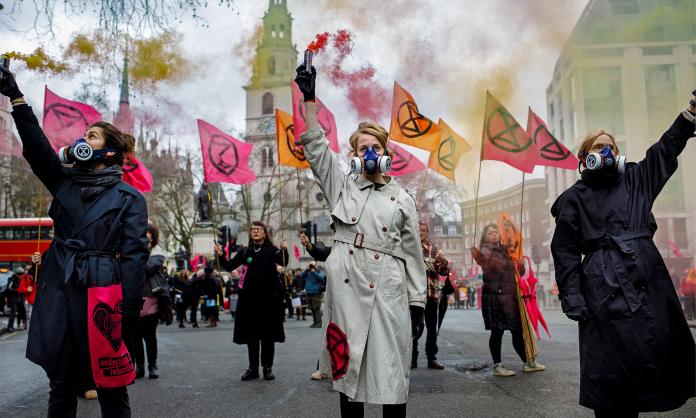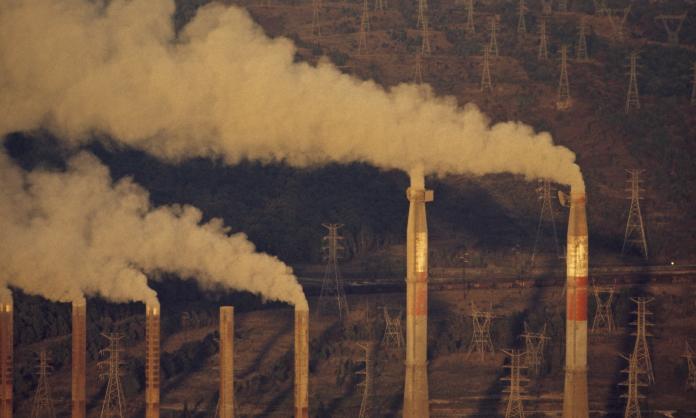The ecological crisis—the disasters of earth, water, air and fire that are afflicting the global environment and the human society that depends on it—is a crisis of capitalism’s making. Karl Marx famously described capital as coming into the world “dripping from head to foot, from every pore, with blood and dirt”. There is no doubt that, just as it came, so too must it go. If we fail, in the coming years and decades, to vanquish the beast of capital that is rapidly degrading Earth’s natural life support systems, it will propel us into a catastrophe that will make the rivers of blood and dirt of capitalism’s first emergence seem like a mere trickle.
Varieties of this apocalyptic vision are shared by many who regard themselves as part of the environment movement. What isn’t widely shared is the identification of capitalism as being the root of the problem. This is a major barrier to winning the radical change we need.
The core, destructive dynamics of capitalism—whether the insatiable drive to short-term profit and the accompanying pressure to minimise costs, the competitive and militarised global scramble for resources or the waste inherent in the chaotic operation of the market—lie at the heart of all the existential environmental challenges we face. As long as we allow our societies to be ruled by these dynamics, we may achieve a little progress here or there, but it won’t be enough to halt the overall slide towards disaster.
This much is obvious from observing the “progress” made by the environment movement in the past few decades. The movement, globally, is huge. It encompasses major political parties such as the Greens, a large number of NGOs with multi-million-dollar budgets, activist organisations with many tens of thousands of members, as well as the tens of millions of people who have participated in environmental actions such as the school strikes for climate. Despite this, on almost any measure, the world’s environment is in a vastly worse state today than it was twenty years ago.
If somehow we could have harnessed the energy from all the lobbying that has been done, all the reports produced, all the summits held and pledges made, we could have powered entire cities. The endless procession of hopeful “new beginnings”, emergency declarations and ambitious-sounding plans has got us nowhere. The rich and powerful have made concessions on marginal issues, but when it comes to anything that might pose a threat to their bottom line, they’ve put up a steadfast and largely successful resistance.
Yet many have been content simply to push on with the same kind of approaches and actions that have brought us to this point. It seems that, every year, the volume of increasingly alarming reports produced by environmental advocacy organisations grows. But why should we expect that politicians will be swayed by scientific arguments now when they’ve shown little interest in the past?
A choice has been made by capitalist politicians. They ignore the warnings of scientists and preserve, for as long as possible, a destructive status quo that has brought untold wealth to the business interests they serve. Their commitment to this project is such that, even if, as happened in Australia last summer, much of an entire continent is consumed by flames, they will continue to deflect, obfuscate and delay in the hope that “business as usual” can continue.
Some, unwilling to confront the unpleasant reality of the environment movement’s lack of progress, have been easy targets for politicians and other powerful people who, increasingly, have concocted a hopeful vision of a “green capitalism” that’s somehow always just around the corner. They’ve been using this trick every five years or so since 1992, when 154 countries signed the United Nations Framework Convention on Climate Change at the Earth Summit in Rio de Janeiro, committing to reducing greenhouse gas emissions to prevent “dangerous anthropogenic interference with Earth’s climate system”.
After the Framework came the Kyoto Protocol and, after that, the Paris Agreement. Each new agreement was celebrated as a turning point in the fight against climate change. But there have been so many turning points that we’ve turned right around in a circle. Or, more accurately, a spiral—because while we’ve been moving through this succession of “groundbreaking” agreements, carbon emissions have spiralled, reaching another record in 2019. Three decades ago, global CO2 emissions totalled 22.4 billion tonnes; last year, they reached 36.8 billion tonnes, a 64 percent increase.
Too many people have been impressed by promises of “zero emissions by 2050”, climate emergency declarations, high-flung rhetoric describing climate change as a “generational challenge”, or fossil fuel companies spruiking their new-found interest in renewable energy. The more we put our faith in such things, the more it benefits those who, behind the scenes, are conspiring to preserve the status quo.
Are we seeing the kind of “rapid, far-reaching and unprecedented changes in all aspects of society” that the authors of the UN Intergovernmental Panel on Climate Change’s 2018 report argued were necessary to keep warming to the “safe limit” of 1.5 degrees Celsius? No. At best there are very minor, incremental improvements in particular areas, while the overall structure of the economy is preserved. If we continue on this track, we’ll find ourselves in 2050 looking back at 2020 as we now look back at 1992—the year of that first great “breakthrough agreement” on climate change in Rio.
Many of the Green New Deal (GND) programs of state-led reform should be included in this. Increasingly, such proposals are being integrated into the arsenal of greenwashing rhetoric deployed by politicians to delay any real action on the climate. The fashionable GND “brand” is today being used to promote almost any proposal for government stimulus—whether or not it relates to climate change or other environmental issues. But even the radical versions of it foresee change occurring without any major disturbance to the existing order. Without challenging capitalism, however, any changes will be limited to what is acceptable to the rich and powerful. And we know from long, bitter experience that what is acceptable to them is far from what is needed.
There are many in the environment movement, of course, who aren’t falling for it. The best are those who, no matter how “green” the rhetoric of politicians and big corporations, are prepared to stand and fight against the destruction of the environment in the here and now—whether it’s new fossil fuel projects such as Adani’s Carmichael coalmine in Queensland, the logging of old growth forests or the poisoning of land, air and sea by big corporations. The actions of the many thousands of people taking part in this resistance are to be celebrated.
There are, however, major limitations to the small-scale direct actions that have long been the stock in trade of the most radical and determined environmental campaigners. The experience of Extinction Rebellion (XR) since its emergence in 2018 as a new, disruptive force in the global climate movement is illustrative. Many thousands of people were inspired by XR’s determination to break with the conservative approaches of the movement and to launch a series of mass disruptive actions targeting the main seats of governmental and corporate power in centres of global capitalism such as London and Paris. But to the extent that XR’s actions managed, where the movement was strongest, to disrupt the normal functioning of a city for a period of days, it was met with state repression.
For XR theorist Roger Hallam, this was all part of the plan. He anticipated that scenes of police arresting peaceful activists would arouse sympathy and support among much wider layers of people. He thought that the determined action of a small minority could trigger a snowball effect in which ever bigger numbers would join them on the streets, until, as he put it in a 2019 interview published in Document Journal, “somewhere along the lines, the system cracks, and you get a deal”.
The reality, unfortunately, was different. The police repression, combined with a massive ideological offensive against XR by the corporate media, meant that, after an initial burst, the numbers on the streets declined and the movement retreated. Today, the initial excitement around XR has all but dissipated, and the activists still committed to the project appear to be limiting themselves to small stunts designed to maximise media attention rather than cause any serious disruption.
This illustrates that the modern capitalist state is hyper-partisan—it is an instrument in the hands of the capitalist elite—and extremely powerful. When the state perceives a threat to capitalist interests, it will employ both ideological and physical force to quash it. In many places, the state’s response to increases in disruptive action by environmentalists hasn’t been (as Hallam envisioned it) to come to the negotiating table, but to increase police resources and pass laws targeting activists. This is a power that can’t be countered by the actions of a minority, however determined it may be.
That’s why the working class is key to winning radical change. The environment movement we need starts with a recommitment to the kind of mass disruptive action that characterised the early period of XR. But if we’re to develop the sort of power we need to change the world, we have to go further. Workers are the one social force capable of genuinely threatening capitalism. Without the world’s billions of workers, the economy would cease to function. The withdrawal of labour—the act of going on strike—is thus a powerful weapon. And it is much more difficult to counter with direct state repression than other types of protest. It doesn’t make much sense to kill, maim or lock people up if what you want is for them to get back to work.
The kind of collective and democratic decision-making bodies that workers establish in the course of struggle (from strike committees in single workplaces, right up to workers’ councils drawing together thousands of elected delegates from workplaces across entire countries), can provide the basis for an entirely new, democratically planned social economy. A new society of this kind will be necessary if we are to have any hope of making the rapid and far-reaching changes to the economy that are required to avert catastrophe and put the world back on a sustainable course. We need careful, long-term planning and cooperation. Without liberating ourselves from the competitive dynamics of capitalism, that will be impossible.
The environment movement we need has to set itself on a course to revolution. In the German Ideology, Marx wrote that “revolution is necessary ... not only because the ruling class cannot be overthrown in any other way, but also because the class overthrowing it can only in a revolution succeed in ridding itself of all the muck of ages and become fitted to found society anew”. The second part of this passage is particularly important. It’s easy to understand that we need to overthrow the environmental vandals who currently rule and who sacrifice the future of the planet to the profits of big business. What’s less often considered is how we are to win a critical mass of people to carry out the actions, and make the changes required to rebuild society on a sustainable basis.
We need revolution to defeat the entrenched opponents of change, and to create a situation in which the mass of workers and the poor empower themselves to decide the direction of society. Only in that context can we expect to see the kind of shift in mass consciousness that will make a genuine global revolution in sustainability possible.
Finally, the environment movement we need must be driven by hope. Not the hope that those in power are already leading us down the path to a better future, or the hope that they can be convinced to do so, but the hope that we ourselves—workers, the poor and the oppressed—can build ourselves into a power that can overturn the world.











